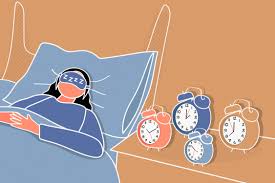A common question is, “How can I fall asleep faster?” The solution is found in a mix of physical and mental clues The Best Ways to Go to Sleep and Stay in It
- For better , practise visualisation or guided meditation before bed.
- Don’t nap for more than 30 minutes.
- A strategy to lessen worried thoughts is to practise cognitive shuffling.
- Don’t check your phone when you wake up in the middle of the night.
Eliminating stimulants, lowering stress levels, and engaging in mindfulness exercises before bed are some strategies to help you stop waking up at three in the morning.
Enhancing Your Sleep Environment
In order to maintain a -friendly schedule, your bedroom is essential. For the best possible environment:
- Use a mask or blackout curtains.
- To shut out distractions while you , try using white noise.
- Include warm lighting that promotes.
- If your bedroom feels chaotic or stressful, think about doing a makeover.
Top Supplements and Foods for Improved
Your is impacted by what you eat. Included in sleep-friendly nutrition are:
- foods like bananas, almonds, and kiwis that promote
- Sleep-promoting magnesium can be found in almonds and dark leafy greens.
- Try this famous mocktail made with sour cherry juice and magnesium, called “sleepy girl.”
- Steer clear of coffee, large meals, and spicy foods right before bed.
Before bed, do a digital detox.
Sleep and screen time are frequently incompatible. Here’s how to establish a ritual devoid of technology:
- Put on blue light-blocking eyewear.
- On gadgets, put them in night mode.
- A digital curfew should be set sixty minutes before to bedtime.
- Use reading, journaling, or an evening yoga practice in place of screens.
Chronotypes and Timing
Your schedule might be more efficiently aligned if you are aware of your natural chronotypes, such as night owls or early bird. Instead of fighting your circadian cycle, learn to work with it. Put into practice:
- synchronising with daylight.
- using your chronotype to determine when you should .
- utilising sleep phase advance or delay strategies to re-establish your routine.
Procedures for Particular Groups
- Teenagers’ sleep schedules should adapt to their changing biological clocks. Promote a wind-down without technology.
- Blackout curtains and regular post-shift wind-down procedures should be the top priorities for shift workers’ sleep schedules.
- Busy professionals may incorporate guided sleep meditation, time-blocking relaxation, and supplementation into their sleep regimen.
Popular Sleep Tricks That Are Worth Trying
Some recent developments in have shown promise:
- Sleepmaxxing is the process of optimising all aspects
- Sleep-related mouth taping enhances nasal breathing.
- Using grounding sheets could help lower inflammation.
- tourism: vacationing with an emphasis on restful.
- Social media advocates share tricks and routines.
Always do your homework and speak with a doctor before attempting new trends, such as supplements or the accuracy of trackers.
The Sleep Cycle: Unlocking Better Rest

The sequence of discrete stages that recur throughout the night is referred to as the cycle. Each whole cycle has four main stages and lasts roughly 90 to 110 minutes:
Stage 1: NREM (light )
This is when people go from being awake to sleeping.
Muscle contractions may occur suddenly, and muscle activity decreases down.
Stage 2: NREM, or deeper light
Body temperature and heart rate decrease.
With short spikes in activity, brain waves decelerate down.
Stage 3: NREM, or deep
Slow-wave is another name for it.
vital for immunological response and physical recuperation.
Stage 4: Rapid Eye Movement (REM)
During this phase, dreams take place.
Your body temporarily becomes paralysed, but your brain activity increases.
The Significance of the Sleep Cycle
Optimising sleep and improving general health require an understanding of the cycle. such as missing deep or REM sleep or waking up frequently.
- Among the main advantages of a complete cycle are:
- Consolidation of memory and mental clarity
- Stability of emotions and stress reduction
- Cell growth and repair
- Improved immunological response
- Weight control and a balanced metabolism
You wake up feeling rejuvenated when your cycle is regular and full. When it is disturbed, irritation, grogginess, and poor concentration ensue.
Things That Throw Off the Sleep Cycle
Your sleep cycle may be disrupted by a variety of lifestyle decisions and medical conditions:
- Unusual sleep patterns
- Overuse of screens right before sleeping
- Anxiety and tension
- Late-day use of alcohol or caffeine
The quality of your can be negatively impacted by even one night of interrupted cycles, which can leave you feeling exhausted and mentally hazy the following day.
Conclusion: Live Brighter, Sleep Better
One of the best things you can do for yourself is to better. A customised sleep optimisation approach may transform your life, regardless of your role—student, shift worker, busy mom, or anybody else in between.
Use these techniques for creating a calming nighttime routine, have a regular sleep schedule, and concentrate on hygiene. Never undervalue the importance of good habits since you live a better life when you get enough.
Every stage https://dailyfittips.com/sleep-routines-for-every-life-stage/

